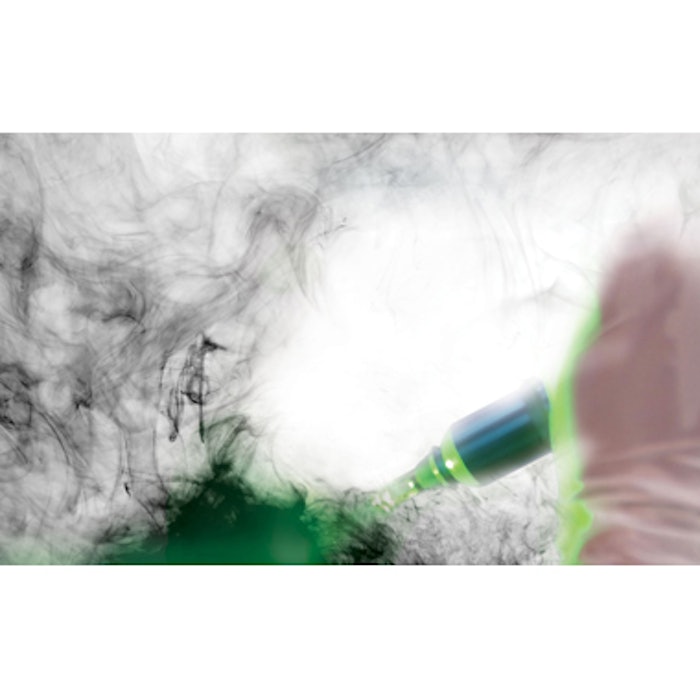
Surgical lasers have improved efficiency and allow for more targeted, less traumatic treatments. But they have also introduced a new danger to providers and patients: laser plumes. Tissue-vaporizing devices emit plume: smoke, vapor and debris that contain harmful compounds, including aerosolized biological materials.
“When you look at the content emitted during cautery, laser treatments or procedures using ablative ultrasonic devices, 95 percent is water and 5 percent is particulate,” says Patti Owens, BSN, RN, MHA, CMLSO, CNOR, consultant and laser practitioner at Online Laser Training USA and AestheticMed Consulting International in Indio, California, and laser practitioner at Mark Sofonio, MD, FACS, in Rancho Mirage, California. “Through in-depth analysis from a variety of studies stemming back to the 1980s, researchers have identified 150 harmful compounds that may be emitted during surgical and aesthetic laser procedures.”
The U.S. Occupational Safety and Health Administration (OSHA) notes that, to date, there have been no reports of transmission of communicable disease from laser or cautery plumes. With relatively little known about the potential harm of short- and long-term exposure to laser plume particulate, OSHA currently has no regulatory requirements. But several professional associations, including the American Society for Lasers in Medicine and Surgery (ASLMS), have developed guidelines to protect practitioners and patients. Following are the latest recommendations to help practices develop their own laser plume safety protocols.
Cause for Concern
Harmful and potentially harmful compounds found in plumes, particularly those emitted by ablative—or tissue-vaporizing—devices include blood particles, viral particles, including HPV and HIV, as well as particles of viable bacteria, such as staphylococcus and neisseria.
“Other harmful compounds found in plume include: aromatic hydrocarbons, such as benzene, which is a carcinogen; toluene, which can cause liver damage; acrolein, a toxic irritant; hydrogen and cyanide; and inorganic gases such as carbon monoxide,” says Owens. “Researchers have also found nanoparticles smaller than five microns, which can lead to lung damage.”
Even nonablative lasers pose risks. Gary S. Chuang, MD, et al, surprised the aesthetics community when they identified 377 chemical compounds in laser hair removal plume—13 of which are known or suspected carcinogens and more than 20 of which are known environmental toxins—in a study published in December 2016 in JAMA Dermatology.
“Most research has been on cauterizing devices, but laser hair removal is not a vaporizing procedure,” says Owens. “So now we are looking at procedures that don’t necessarily produce vaporization of tissue.”
Laser tattoo removal also creates potentially harmful plume, according to a study awaiting publication by Michael Murphy, BSc, MSc. When utilizing a Q-switched Nd:YAG laser for tattoo removal, high optical laser irradiances created fragmentation and minuscule splatter. By holding a glass slide onto the skin, Murphy demonstrated that the high velocities generated during the photoacoustic process resulted in ejection of some tattoo ink particles into the air. “When he lifted the glass slides up, there was an impression of the tattoo ink,” says Owens. “Some of Murphy’s preliminary studies also showed gram negative bacteria on these slides.”
So how can you prevent these harmful compounds from entering the respiratory tracts of providers and patients? Two of the most effective tools in reducing the risk of air-borne particles and nanoparticles are a good smoke evacuator system and physical barriers that trap ejected materials.
Clearing the Air
While performing laser hair removal, Dr. Chuang recommends using a smoke evacuator that has both charcoal and particulate filters and positioning it as close to the treatment site as possible. Providers should also wear an N95 particulate-filtering respirator and run HEPA filters in the treatment room. “These filters circulate the air and filter out particulates that were not picked up by smoke evacuators,” says Dr. Chuang.
The 2017 ASLMS Laser and Energy Device Plume Position Statement recommends using high-flow volume (25 to 50 cubic feet per minute) smoke evacuators and changing the filters per manufacturer instructions. “Plume evacuators have a pre-filter that collects large smoke particulate and fluid, and a secondary filter called an ultra-low penetration air (ULPA) filter, which captures particulate and microorganisms down to 0.12 micron,” Owens says. “A third section, the charcoal filter, absorbs toxins and organic gases. By holding the suction wand or tubing as close as possible to the source of emission—at one inch, you collect 90 percent; at two inches, 50 percent—you’ll get a higher collection.”
Because bacteria can stay viable for up to 72 hours in tubing and suction hoses, “wands, filters and tubing should be treated as hazardous biocontaminated material and discarded after each use,” says Owens.
Laser technicians should also use personal protective equipment, such lab coats, laser goggles and gloves to prevent exposure, says George J. Hruza, MD, MBA, adjunct professor of dermatology, St. Louis University, St. Louis, Missouri.
Blocking Splatter
Physical barriers, such as sapphire contact cooling, laser gels and plastic cones, can help trap particulate before it becomes airborne. A December 2017 study, “Airborne particulate concentration during laser hair removal: A comparison between cold sapphire with aqueous gel and cryogen skin cooling,” published in Lasers in Surgery and Medicine, showed that laser hair removal devices with contact cooling emit significantly less particulate when compared to similar devices using cryogen spray.
Emily Eshleman and Dr. Chuang, et al, found that gels used during laser hair removal procedures also help to trap particulate when they examined particulate matter emitted during alexandrite and diode laser hair removal procedures. For their paper, “Occupational exposures and determinants of ultrafine particle concentrations during laser hair removal procedures,” published in Environmental Health in March 2017, the researchers held a smoke evacuator 12 inches from the treatment site and used an ultrasound gel called Lux Lotion to facilitate treatment when using the diode laser. They found that emissions were reduced up to 60 percent when using the gel with the diode, compared to lack of gel with the alexandrite laser.
For laser tattoo removal procedures, a physical barrier such as perfluorodecalin (PFD) patches (DESCRIBE PFD Patch, Merz Aesthetics), clear acetate shields, hydrogel sheets or plastic cones that come with laser tattoo removal devices can protect against tattoo dye splatter-emitted particles.
“Be sure to discard any contaminated tubes or cones between patients; most are designed for single use,” says Dr. Hruza, although he adds that some cones can be cleaned and autoclaved for reuse.
Developing a Practice Protocol
Though OSHA offers no specific laser plume standards, several professional organizations and government agencies have published position statements and voluntary standards for guidance. They include the ASLMS Position Statement, available at www.aslms.org; the Laser Institute of America’s “American National Standard for Safe Use of Lasers in Healthcare” (ANSI Z136.3 2011), available at www.lia.org; the Centers for Disease Control and Prevention’s “Control of Smoke From Laser/Electric Surgical Procedures” (www.cdc.gov); and the International Council on Surgical Plume (www.plumecouncil.com).
Take the initiative to prevent harmful compounds from entering the respiratory tracts of practitioners, patients and yourself. By developing your own best practices and protocols, all of your team members will breathe a little easier.
Karen Appold is a freelance writer based in Pennsylvania.
Image Getty Images











